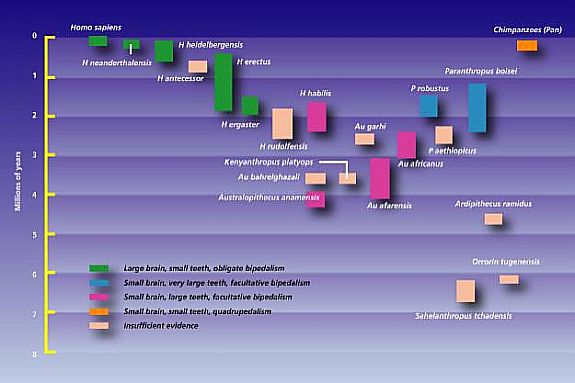- Went over part of our homework
- We specifically went over pages 63 and 65.
- The order that the images went from oldest to most recent was:
- D, C, (E, F), H, A, G, B -> E and F are in parenthesis because they were alive at the same time
- Finished taking notes in notes packet
- We had a note page that was not in our packet, but it said:
- Science Breakthrough of 2001 Ardipithecus ramidus.
- - rare skeleton
- -4.4 million years old
- - unlike living apes or later homonids
- - walked upright-the historical defining trait of a member of the human family
- - lived in woodlands , not open grassy terrain
- Homo Habilis, Homo erectus, and the neanderthals are three different species that were included in our notes
- Homo sapiens are regionally diverse and the oldest Homo Sapien is over 300,000 years old which can include neanderthals
- - we are homo sapiens sapiens

- Multiregional hypothesis- modern humans evolved simultaneously in different parts of the world. Accounts for genetic similarity due to interbreeding among neighboring populations----- one hypothesis of what happened to Homo erectus descendants
- 1st graph
- "Out of Africa" hypothesis- modern humans arose from a single archeac group in Africa who spread out of Africa 100,000 years ago, some of which became genetic dead ends. (genetic evidence mostly supports this) ----- second hypothesis of what happened to Homo erectus descendants
- 2nd graph
- our erect stance, and enlargement of brain are radical anatomical changes in our evolution
- 3 culture stages
- -nomads
- -Agricultural
- -industrial
4. Went over our quiz
- the answer to the first question is D- it is not an error
- question number 19 is c because 160/500 =1/4 = .25. .25 represents q^2. and because the question is asking 'what is the frequency of the undesirable allele in the herd?' we know that we need to find q. Therefore we took the square root of .25 to get q which is .5. Therefore the answer was C.
6. Other
- Homework: study for test on Monday
- Scribe: Vinise
- Next Scribe: Lydia
I like how much detail you put into your post! It really helped me to look at the 2 hypotheses for where humans arose from, and then to look at the chart right below it. I also really like the bluish-purplish chart because it shows how evolution works (the key helps too). Great job!! :)
ReplyDelete